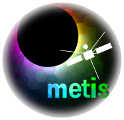Speaker
Description
On October 28, 2021 the first X-class solar flare of Solar Cycle 25 occurred in active region NOAA AR 12887 with a peak at 15:35 UT, producing the rare event of ground-level enhancement of the solar relativistic proton flux and a global extreme ultraviolet (EUV) wave, along with a fast halo coronal mass ejection (CME) as seen from Earth's perspective. A few hours before the flare, a slower CME had erupted from a quiet Sun region just behind the northwestern solar limb. Solar Orbiter was almost aligned with the Sun-Earth line and, during a synoptic campaign, its coronagraph Metis detected the CME events in both the VL and UV channels. The earlier CME took place in the north-west (NW) sector of Metis field of view, while several bright features of the flare-related event appeared mostly to the south-east (SE).
The NW and SE events have two distinct origins, but were both characterized by an exceptionally bright emission in HI Ly-alpha in the UV images of Metis up to 8 solar radii. This work is a follow-up study of two out of the six events analyzed by Russano et al. 2023, aimed at investigating the evolution of these two almost co-temporal CMEs but originating in such distinct source regions. To that end, we extensively inspect data sets from numerous remote-sensing instruments observing the Sun in several spatial and spectral regimes. We track the erupting prominences associated with both CMEs with respect of their outer envelopes, from their source regions until the outer corona, by means of three-dimensional reconstruction techniques. Preliminary results of this work in progress point to notable differences between these two events showing significant UV emission in the corona.

